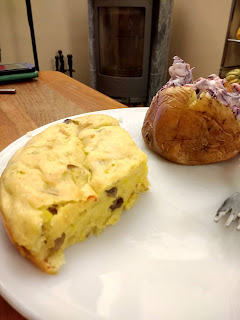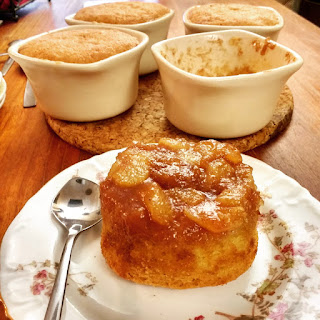With Halloween done and dusted on Saturday, it seemed a little brutal to get stuck in to cutting up the pumpkin lanterns the next day but it was a Sunday, so there was time to do some processing and start making good use of the stuff whilst it was still fresh.
I started by turning a pound and a half of a lantern into pumpkin soup. Normally I would use 1lb of pumpkin and 1lb of butternut squash to make the soup but I didn't have any butternut squash so I used a pound and a half of pumpkin and 8 oz of potatoes to add the creamy texture usually provided by the butternut squash. With all the usual flavours added, it wasn't noticeable that I had changed the recipe.
Pumpkin & Potato Soup
1
lb 8 oz cubed pumpkin flesh
8 oz peeled and cubed potatoes
2 garlic cloves, chopped
10 fl oz vegetable stock
5 fl oz sieved tomatoes (or passata) or 2 tbsp tomato puree
1 tsp curry powder
Salt & pepper to taste
Put some oil in the bottom of a large saucepan and gently saute the cubed
vegetables for about 5 minutes then add the garlic and fry for another
minute. Pour in the stock and tomatoes and add the curry powder. Put a lid on
the pan and simmer for 30 minutes until the vegetables are soft. Blend until
smooth, taste and season as necessary. Eat hot or cool and freeze in portions.
Whilst the soup was cooking, I put another lot of pumpkin chunks on to steam so by the time we had finished lunch, it was possible to use some to make pumpkin puree for the cheesecake and ice-cream ideas I had in mind.
Pumpkin Ice-cream
450g fresh pumpkin
300ml whipping cream
120g light brown sugar
1 teaspoon ground cinnamon
1/2 teaspoon ground ginger
1/4 teaspoon nutmeg
Pinch ground cloves
Pinch of salt
Peel and chop the pumpkin then steam until soft. Mash until a smooth puree is
formed. Put all the ingredients in a blender and blend for about a minute until
well mixed. Pour into suitable containers and put in the freezer. Take out of
the freezer after 2-3 hours and whip up with a fork to break up the ice
crystals before returning to the freezer.
With the ice-cream in the freezer, I turned my attention to the cheesecake. I had made pumpkin cheesecake a few years back but it was a baked one and I think on the whole we prefer non-baked cheesecakes - they are certainly easier to make! The previous weekend I had made a totally delicious pear and gold chocolate cheesecake, served with pear and vanilla ice-cream and I really wanted to repeat the dessert this weekend but with the seasonal ingredients of pumpkin. So, stocked with luxury chocolate from The Chocolate Mill MK, I decided to pretty much follow last week's recipe but use ruby chocolate this time.
I was confident about the flavours but I really wasn't sure what colour the cheesecake would end up and I thought there was a possibility that the orange of the pumpkin puree, mixed with the pink of the ruby chocolate would make an unpleasant brown colour but in fact it turned into an attractive golden brown, just enough of a colour to hint at the pumpkin and spice flavours, and perfectly complimented by the gingerbread-like spiced ice-cream. Lovely!
For the base
150g digestive or ginger biscuits, crushed in a blender
75g butter, melted
For the topping
100g pumpkin puree
1/2 tsp mixed spice
200g ruby chocolate
30g butter
250g cream cheese
90ml whipping cream
For the biscuit base combine the crushed biscuits and the
melted butter in a bowl then press into the greased base of a 20cm circular tin
or dish. Place in the refrigerator for at least half an hour to solidify.
Next, melt the chocolate and butter in a bowl over a pan of
simmering water. Leave to cool. In another bowl, mix together the cream and
cheese and beat until smooth. Once the chocolate mix is suitably cool add it to
the cream mix and stir thoroughly. Add the pumpkin puree and mixed spice and stir in.
Spoon the mixture onto the biscuit base. Return to the refrigerator to chill
for a few hours or over night.





















































